 The Millennium Tower, right, stands in San Francisco. It was touted as the most luxurious tower in San Francisco, but started to sink. Photo: David Paul Morris
The Millennium Tower, right, stands in San Francisco. It was touted as the most luxurious tower in San Francisco, but started to sink. Photo: David Paul Morris Nina Agabian, a retired director of research in global health science at the University of California, bought a 29th-floor apartment in San Francisco’s Millennium Tower in 2010. “It was supposed to be a wonderful building,” she said. “For many of us, who left our business lives to start our older years, this had become a nice, comfortable place.”
The building, which opened in 2008 and was touted as the most luxurious tower in San Francisco, became a beacon of the city’s burgeoning wealth, attracting tech millionaires, venture capitalists, and footballers.
The 58-storey tower’s shine faded on May 10, 2016, when Agabian was informed that the building had sunk 16 inches into the earth and tilted over 15 inches at its tip and two inches at the base, according to legal suits filed by residents and the city of San Francisco.
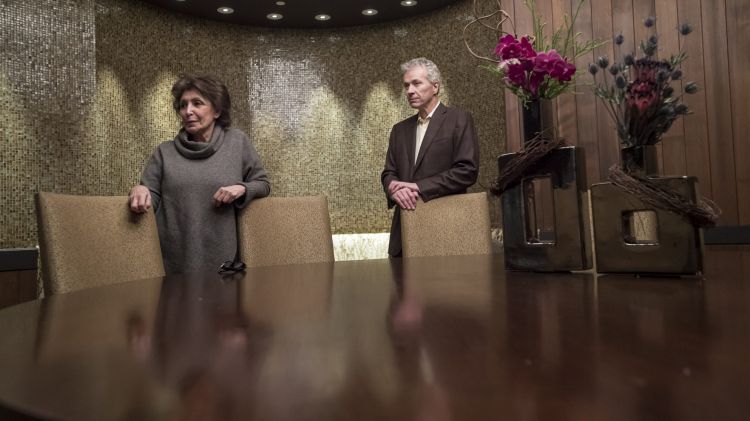 Nina Agabian, left, and Jerry Dodson, residents of the Millennium Tower. Photo: David Paul Morris
Nina Agabian, left, and Jerry Dodson, residents of the Millennium Tower. Photo: David Paul Morris
“You can imagine how distressed we were to know that, for one, our lifetime investment and savings are at risk,” she said. “And we have no idea whether or not there’s a fix to it, and if there is a fix to it, what it will entail.”
The building, meanwhile, continues to sink.
As Agabian and more than 20 other residents file multiple lawsuits against the building’s developer, the city of San Francisco, and the Transbay Joint Powers Authority, another, potentially more ominous development has emerged.
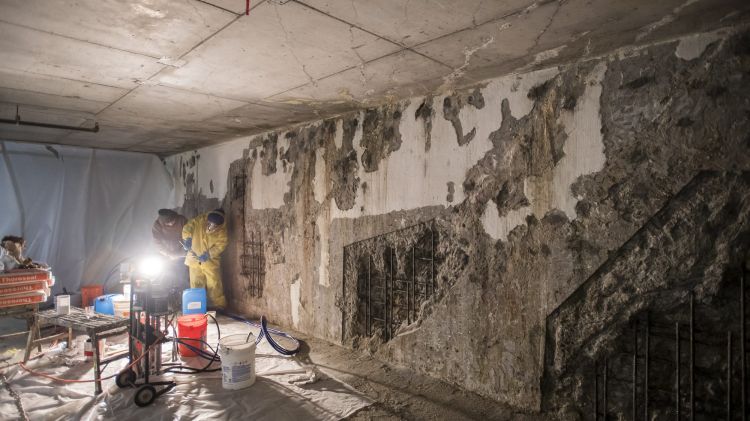 Workers repair crumbling walls that have been the result of leaking water in the garage of the Millennium Tower. Photo: David Paul Morris
Workers repair crumbling walls that have been the result of leaking water in the garage of the Millennium Tower. Photo: David Paul Morris
Two people with knowledge of Millennium Partners’ liability policy say the developer is insured to cover some $100 million in damages caused by settlement or construction defects; the policy is split among several insurers. Ancillary policies held by the building’s architect, structural engineer, and general contractor are worth another $50 million to $100 million, according to one of the people. Any legal fees incurred by the policyholders could be deducted from their policies. But according to experts, fixing whatever is causing the building to tilt could cost far more than that amount.
Further adding to residents’ woes is that it’s not even clear if coverage will be available under the liability policy: It might have been voided by the flaws in the building.
It’s possible that homeowners already under water on their damaged real estate investments may have to cover millions in costs to repair the building. And that’s not even the extreme worst-case scenario. In 1989, some buildings on loose San Francisco soil collapsed during an earthquake. The city has asked Millennium Partners for information on how much the building can further settle without compromising the building’s stability and how it will perform during a quake. In a letter dated January 13, 2017, MP declined to supply the city with that data, citing ongoing litigation and mediation.
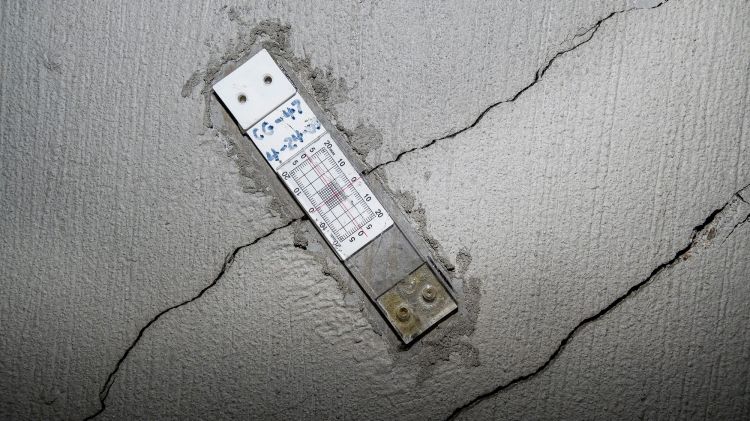 A stress gauge is seen on a wall with floor-to-ceiling cracks in the parking garage. Photo: David Paul Morris
A stress gauge is seen on a wall with floor-to-ceiling cracks in the parking garage. Photo: David Paul Morris
Surrounding the building is the $1.1 billion new Salesforce Tower, the new condominium tower 181 Fremont, and a neighbourhood bar.
While the best method of fixing the building’s tilt won’t be known until an engineering firm hired by the developer completes its investigation, and perhaps not even then, the cost is certain to be millions, and perhaps hundreds of millions, of dollars.
Beyond their lawsuits, the residents can’t hope for recourse from the developer.
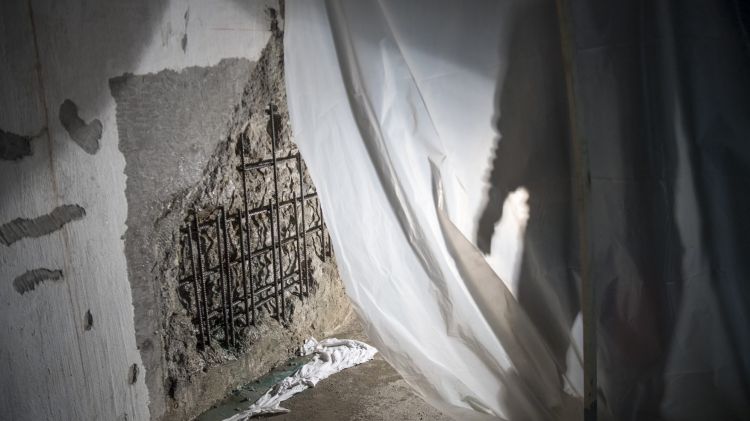 The shadow of a worker is seen repairing a crumbling wall that has been the result of leaking water. Photo: David Paul Morris
The shadow of a worker is seen repairing a crumbling wall that has been the result of leaking water. Photo: David Paul Morris
“Millennium Partners doesn’t own the building,” said P.J. Johnston, a spokesman for the developer. “Even if there was an immediate and agreed upon measure to take, the building is owned by homeowners. Millennium Partners cannot just move forward with any set of measures” to fix the building, he said.
Castle in the Sand
Much of downtown San Francisco, including parts of Mission Street, where Millennium Tower was built, is constructed on loose, wet soil. But the city’s proximity to two major faults could render that same ground unstable in an earthquake, said Keith Knudsen, the deputy director of the US Geological Survey’s Earthquake Science Center. “The soft material tends to amplify the parts of the shaking-the earthquake’s wavelengths-which are damaging to buildings,” he said.
The engineers who designed Millennium Tower were aware that the building sat on unstable soil and constructed the 645-foot tower’s base so it would behave “dynamically” in the event of an earthquake, at least partially withstanding the shocks on the unstable ground. To achieve this effect, they chose a support known as “friction piles”, a series of rods bored into the ground that would help stabilise the building as the earth rocked. While other buildings in the area were built with similar foundations (and still others use pilings drilled all the way down to firmer bedrock), the majority of the skyscrapers in downtown San Francisco are built with steel frames. Millennium Tower, in contrast, is made of vastly heavier concrete.
 Jerry Dodson, a resident of the Millennium Tower. Photo: David Paul Morris
Jerry Dodson, a resident of the Millennium Tower. Photo: David Paul Morris
A decade after the first piles were drilled, walls in the underground parking garage have begun to crack due to the shifting, marble floors in the lobby have begun to buckle, and residents have complained that the ventilation units have begun to fail, raising questions about when the tilt will stop, or if it will stop at all.
Problems Emerge
No one is quite sure why the building began to sink and tilt. It could be a flaw in the structure, which would make it Millennium Partners’ responsibility, according to the building residents, or the result of the nearby construction of a major transit station, which would make it at least partially the responsibility of the station’s builder. Possibly, it could be some combination of the two.
A class-action by 20 building residents, led by their fellow resident, patent litigatorJerry Dodson, alleges that Millennium Partners knew the building had sunk 8.3 inches into the ground by 2009, the year after it was completed.
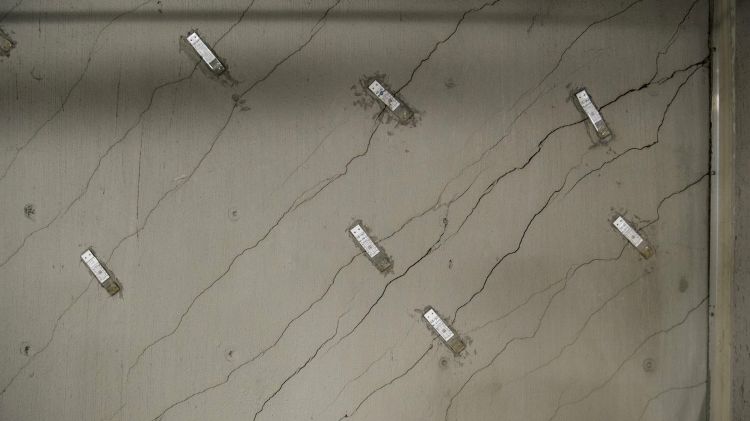 Stress gauges sit on a wall with floor-to-ceiling cracks in the storage area. Photo: David Paul Morris
Stress gauges sit on a wall with floor-to-ceiling cracks in the storage area. Photo: David Paul Morris
“There’s the possibility that when they poured [the concrete base] in 2006-07, that it immediately sank,” Dodson said. “It’s extremely unlikely in my mind that as we began 2009 that it immediately tilted six inches to the northwest. What’s more likely is they poured the [slab] on unstable soil.”
Millennium Partners denies responsibility for the tilting. “At the time of its completion in 2008 and throughout its entire sales process, [Millennium Tower] had settled within predicted, safe ranges,” said Johnston, the developer’s spokesman.
Dodson’s 20 homeowners, who collectively paid some $75 million for their condos, claim that the developer hid the building’s faulty structure from prospective buyers and that the city’s administrators joined in the alleged fraud by helping conceal the tower’s engineering flaws as early as February 2009 by signing mutual nondisclosure agreements. The two colluded over half a decade to keep Millennium Tower’s design defects secret to allow the city to move forward on its own construction in the neighbourhood, according to Dodson’s complaint. The city and Millennium Tower deny these allegations.
Regardless of who is legally responsible, all parties have finally agreed that there is, in fact, a problem.
A report commissioned by Millennium Partners and published in 2014 by the engineering firm Simpson Gumpertz & Heger determined that the building’s support columns and foundation were experiencing “significant stress”. Nevertheless, the report concluded: “With the exception of the foundation,” it read, “none of the settlement-related demands on these elements are at levels that indicate impending failure.” The building’s supports might be cracking, in other words, but-as of a few years ago, at least-it was unlikely to collapse.
Recently, Millennium Partners entered private mediation with building residents, with the goal of halting environmental damage and to “stop any undue further settlement of the building,” according to the developer’s spokesman. As far as Millennium Partners is concerned, the culprit is the TJPA project next door. “We need to ensure that the damage being caused by our immediate neighbours, TJPA, is stopped,” he added.
But Steven Sanders, the president of Sage Engineers, cautioned against jumping to conclusions. “You have to be very careful about these different fixes,” he said. “They’re very dependent on soil conditions and building types.” Millennium Tower, he said, is fairly unique.”I think it would be hard and probably dangerous to say, ‘This is done here, why don’t you do the same thing there?'”
Resale Quagmire
Any fix to the building will almost certainly take several years, and the lawsuits over who will pay for it could take even longer. In the meantime, residents of the building remain in limbo.
“There haven’t been a lot of resales in the building since all of this news came out,” said Gregg Lynn, the Sotheby’s broker. “There’s still no clarity about what it takes to fix or stop the problem.”
“We can’t sell, we can’t rent, we can’t move,” said Agabian, the retired scientist. “I’d sell it in a second if I got fair market value for it.” She corrected herself: “Well, there’s not a fair market for it, because now the fair market for it is zero.”
Other residents are stuck.
“I’m getting a lot of calls from homeowners in the building who want to make plans to list their places once the settlement solution is announced,” Lynn said, adding that he had close to 25 clients in the building.
Currently, just three apartments are on the market: apartment 4E, which has 1,136 square feet and is listed at $1.299 million. There’s also penthouse 1A, listed at $8.995 million. The final apartment, 14C, is a one-bedroom, one-bathroom space with 833 square feet. It’s on the market for $1.08 million.
Bloomberg
